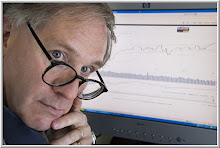 In my recent posts, I've been investigating Relative Dollar Volume Flow in the Dow Jones Industrial stocks as a way of determining whether institutions are putting money to work in the market. By identifying whether each trade in each Dow stock occurs on an uptick or downtick and then multiplying the volume of that trade by the trade price, we can create a cumulative value that represents daily net buying or selling. Dollar volume for trades on upticks is added to the cumulative total; dollar volume for trades on downticks is subtracted from the total. This makes the measure very sensitive to the large trades placed by the market's largest participants. We're looking at the actual dollars these large traders and investors are pouring in and out of stocks. To more readily compare the dollar flows among different issues, I divide each stock's daily dollar volume flow by its daily trading volume to create a *Relative* Dollar Volume Flow.
In my recent posts, I've been investigating Relative Dollar Volume Flow in the Dow Jones Industrial stocks as a way of determining whether institutions are putting money to work in the market. By identifying whether each trade in each Dow stock occurs on an uptick or downtick and then multiplying the volume of that trade by the trade price, we can create a cumulative value that represents daily net buying or selling. Dollar volume for trades on upticks is added to the cumulative total; dollar volume for trades on downticks is subtracted from the total. This makes the measure very sensitive to the large trades placed by the market's largest participants. We're looking at the actual dollars these large traders and investors are pouring in and out of stocks. To more readily compare the dollar flows among different issues, I divide each stock's daily dollar volume flow by its daily trading volume to create a *Relative* Dollar Volume Flow.The chart above represents the Relative Dollar Volume Flow for the Dow Jones stocks (total dollar volume flow for all 30 stocks divided by the total volume of the Dow stocks that day) from January, 2006 through October, 2006. The blue line with hashmarks represents the Dow average (DIA) on a daily closing basis; the red line is the five-day moving average of the Relative Dollar Volume flow. The dark red horizontal line across the chart represents the average five-day flow over the past 100 trading sessions.
Note how dollar flows into the Dow stocks waned as we went into the May highs. In other words, even as price was going higher, less money was being put to work in the Dow issues. That led to a selloff and then substantially reduced dollar volume flows. That pattern is an important one: we have to see reduced dollar volume flowing into stocks to reverse a market rise. Corrections in a rising market will be quite limited if we are seeing expanding money being put to work in stocks.
Conversely, note that we could not identify a bottom in the market until we had a surge of funds put to work among the Dow stocks. That was our sign that institutional investors were seeing those price levels as value and committing their dollars accordingly. From this perspective, you cannot identify a market bottom by crystal ball. You have to identify when lower levels are truly attracting capital and, then, you have a candidate bottom behind you.
You can see from the subsequent rise that the market did not pull back significantly as institutions steadily put dollars to work among the Dow stocks. A market move will continue until large market-moving participants either decide to commit fresh funds to stocks or to withhold further purchases from the market.
So what do these flows of funds tell us about the current market? That will be the topic of my next post.




